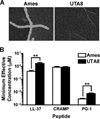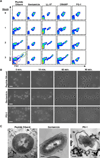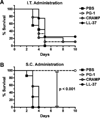Cathelicidin administration protects mice from Bacillus anthracis spore challenge
- PMID: 18802102
- PMCID: PMC4225133
- DOI: 10.4049/jimmunol.181.7.4989
Cathelicidin administration protects mice from Bacillus anthracis spore challenge
Abstract
Cathelicidins are a family of cationic peptides expressed in mammals that possess numerous bactericidal and immunomodulatory properties. In vitro analyses showed that human, mouse, and pig cathelicidins inhibited Bacillus anthracis bacterial growth at micromolar concentrations in the presence or absence of capsule. Combined in vitro analyses of the effects of each peptide on spore germination and vegetative outgrowth by time lapse phase contrast microscopy, transmission electron microscopy, and flow cytometric analysis showed that only the pig cathelicidin was capable of directly arresting vegetative outgrowth and killing the developing bacilli within the confines of the exosporium. C57BL/6 mice were protected from spore-induced death by each cathelicidin in a time- and dose-dependent manner. Protection afforded by the porcine cathelicidin was due to its bactericidal effects, whereas the human and mouse cathelicidins appeared to mediate protection through increased recruitment of neutrophils to the site of infection. These findings suggest that cathelicidins might be utilized to augment the initial innate immune response to B. anthracis spore exposure and prevent the development of anthrax.
Conflict of interest statement
The authors have no financial conflict of interest.
Figures









Similar articles
-
Monoclonal antibody against the poly-gamma-D-glutamic acid capsule of Bacillus anthracis protects mice from enhanced lethal toxin activity due to capsule and anthrax spore challenge.Biochim Biophys Acta. 2013 Mar;1830(3):2804-12. doi: 10.1016/j.bbagen.2012.11.006. Biochim Biophys Acta. 2013. PMID: 23201204
-
A bivalent protein r-PB, comprising PA and BclA immunodominant regions for comprehensive protection against Bacillus anthracis.Sci Rep. 2018 May 8;8(1):7242. doi: 10.1038/s41598-018-25502-9. Sci Rep. 2018. PMID: 29740033 Free PMC article.
-
Functional characterization and evaluation of protective efficacy of EA752-862 monoclonal antibody against B. anthracis vegetative cell and spores.Med Microbiol Immunol. 2020 Apr;209(2):125-137. doi: 10.1007/s00430-019-00650-5. Epub 2019 Dec 6. Med Microbiol Immunol. 2020. PMID: 31811379
-
Potential use of inhibitors of bacteria spore germination in the prophylactic treatment of anthrax and Clostridium difficile-associated disease.Expert Rev Anti Infect Ther. 2007 Oct;5(5):783-92. doi: 10.1586/14787210.5.5.783. Expert Rev Anti Infect Ther. 2007. PMID: 17914913 Review.
-
The development of new vaccines against Bacillus anthracis.J Appl Microbiol. 2001 Oct;91(4):609-13. doi: 10.1046/j.1365-2672.2001.01498.x. J Appl Microbiol. 2001. PMID: 11576296 Review. No abstract available.
Cited by
-
Pegylation of antimicrobial peptides maintains the active peptide conformation, model membrane interactions, and antimicrobial activity while improving lung tissue biocompatibility following airway delivery.Antimicrob Agents Chemother. 2012 Jun;56(6):3298-308. doi: 10.1128/AAC.06335-11. Epub 2012 Mar 19. Antimicrob Agents Chemother. 2012. PMID: 22430978 Free PMC article.
-
Acinetobacter baumannii: an emerging opportunistic pathogen.Virulence. 2012 May 1;3(3):243-50. doi: 10.4161/viru.19700. Epub 2012 May 1. Virulence. 2012. PMID: 22546906 Free PMC article. Review.
-
Transient lipopolysaccharide-induced resistance to aerosolized Bacillus anthracis in New Zealand white rabbits.Comp Med. 2013 Jun;63(3):252-61. Comp Med. 2013. PMID: 23759528 Free PMC article.
-
Cationic host defense peptides; novel antimicrobial therapeutics against Category A pathogens and emerging infections.Pathog Glob Health. 2016 Jun-Jul;110(4-5):137-47. doi: 10.1080/20477724.2016.1195036. Epub 2016 Jun 17. Pathog Glob Health. 2016. PMID: 27315342 Free PMC article. Review.
-
Chemokine-Releasing Microparticles Improve Bacterial Clearance and Survival of Anthrax Spore-Challenged Mice.PLoS One. 2016 Sep 15;11(9):e0163163. doi: 10.1371/journal.pone.0163163. eCollection 2016. PLoS One. 2016. PMID: 27632537 Free PMC article.
References
-
- Ganz T. Defensins: antimicrobial peptides of innate immunity. Nat. Rev. Immunol. 2003;3:710–720. - PubMed
-
- Yang D, Chertov O, Oppenheim JJ. Participation of mammalian defensins and cathelicidins in anti-microbial immunity: receptors and activities of human defensins and cathelicidin (LL-37) J. Leukocyte Biol. 2001;69:691–697. - PubMed
-
- Finlay BB, Hancock RE. Can innate immunity be enhanced to treat microbial infections? Nat. Rev. Microbiol. 2004;2:497–504. - PubMed
-
- Hancock RE, Diamond G. The role of cationic antimicrobial peptides in innate host defenses. Trends Microbiol. 2000;8:402–410. - PubMed
Publication types
MeSH terms
Substances
Grants and funding
LinkOut - more resources
Full Text Sources
Other Literature Sources
Medical
Molecular Biology Databases

